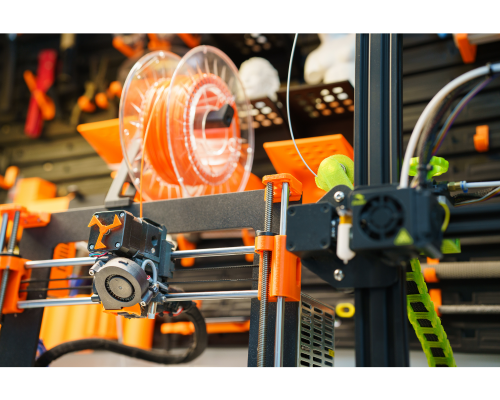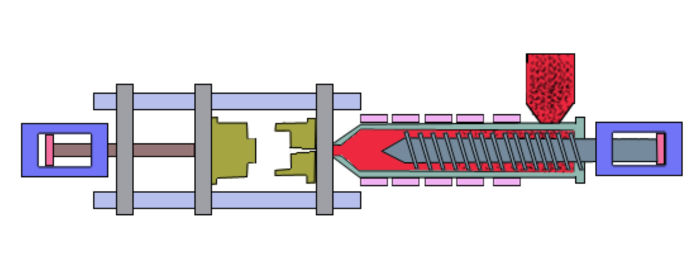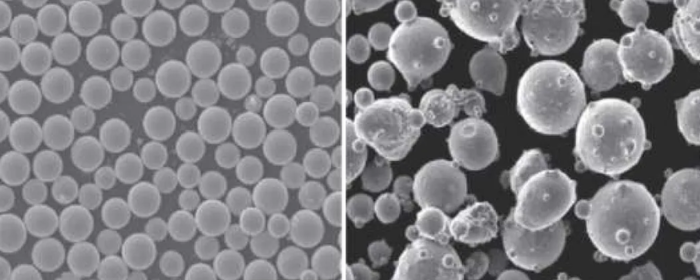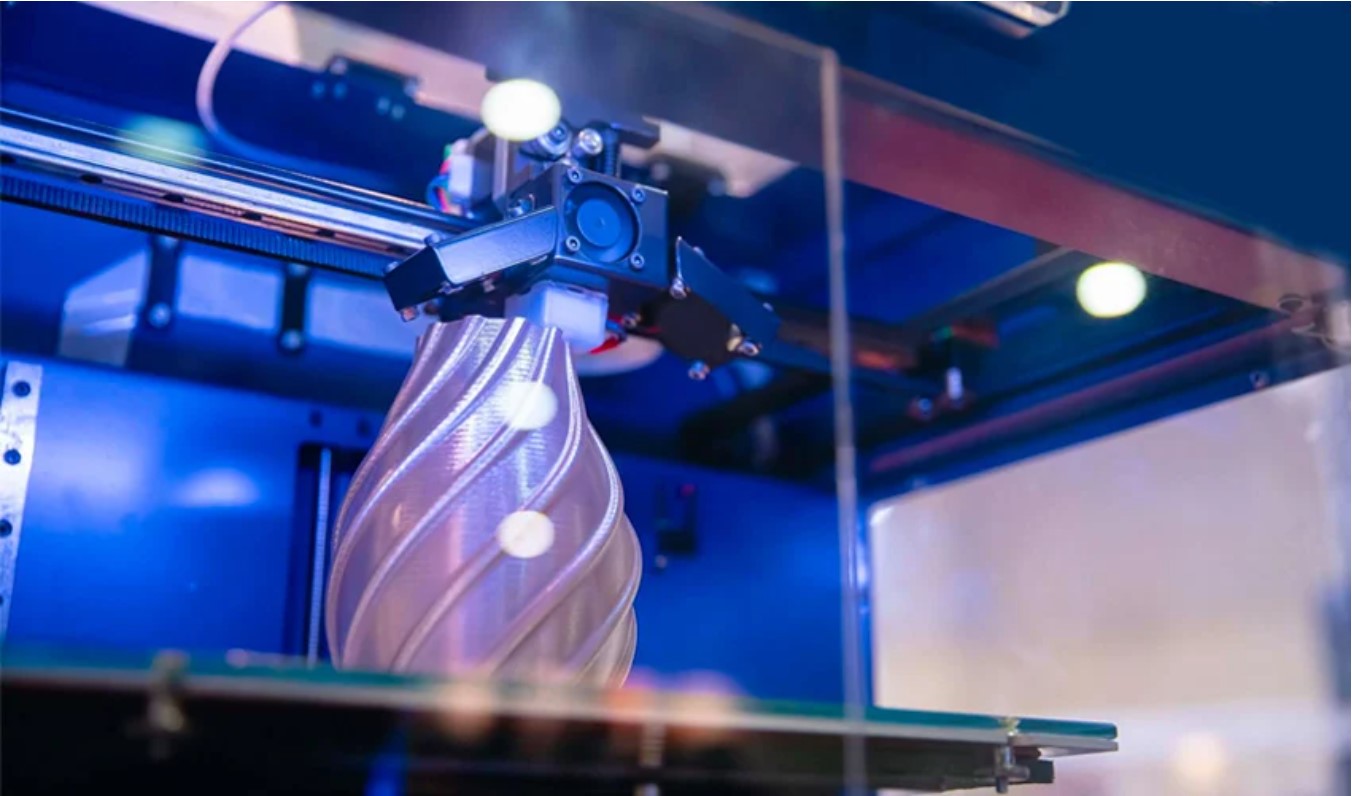

Additive manufacturing is a rapid manufacturing technology whose main feature is to build the required three-dimensional structure through layer-by-layer accumulation of materials. Its advantage is that it can manufacture complex structural parts, save materials, manufacture small batches or personalized products, and manufacture multi-material assemblies, which brings new opportunities for the development of high-end manufacturing. Metal powders play an increasingly important role in the field of additive manufacturing, and the applications of various materials such as titanium-based, aluminum-based, cobalt-chromium and nickel alloy powders are constantly expanding. In particular, titanium-based alloy powder has become one of the hot spots of research due to its outstanding performance in aerospace, biomedicine and other fields, as well as the continuous advancement of laser additive manufacturing technology.

3D Printer is working
Titanium-based alloys have the characteristics of high specific strength, good corrosion resistance, high heat resistance and good biological activity.
Laser additive manufacturing of titanium alloys has the advantages of short processing cycle, low manufacturing cost, high flexibility, etc., and the formed parts have higher strength than forgings.
Titanium-based alloys have been widely used in aerospace, biomedicine, marine and automotive, metallurgical and chemical industries in recent years. Laser additive manufacturing of titanium alloys has received increasing attention in related fields due to the above advantages.
The development of new titanium-based alloys is the main direction of research on the application of titanium alloy additive manufacturing.
Re-Ti alloy: Due to the low strain hardening index of titanium and titanium alloys (approximately 0.15), poor resistance to plastic shear deformation and poor wear resistance, the use of its parts under high temperature and corrosive wear conditions is limited. Rhenium (Re) has a very high melting point and is generally used in ultra-high temperature and strong thermal shock working environments. The preparation of Re-Ti alloys is of great significance in the fields of aerospace, energy and electronics.
Ni-Ti alloy: Nickel (Ni) has magnetism and good plasticity, so Ni-Ti alloy is a commonly used shape memory alloy. Ni-Ti alloy has properties such as pseudo-elasticity, high elastic modulus, damping properties, biocompatibility and corrosion resistance, and has been used to carry human mesenchymal stem cells to promote research on bone defect regeneration.
Aluminum is the second most abundant metallic element on earth after iron, and it is also one of the most widely used nonferrous metals in industrial materials today. The density of pure aluminum is small, only 1/3 of the density of iron, and the melting point is low. Aluminum has a face-centered cubic structure, so it has strong plasticity and can be made into materials of various shapes as needed. At the same time, the corrosion resistance of aluminum alloys, It has good thermal and electrical conductivity and strength.
Aluminum metal is used on a large scale in aerospace, automobiles, ships, machinery manufacturing, etc. The aluminum alloy powders currently available for additive manufacturing on the market include: AlSi10Mg, AlSi12, 6061, 7050 and 7075.
These aluminum alloy powders offer engineers and designers a wide range of additive manufacturing options to produce complex geometries, reduce material waste and enhance performance characteristics. As additive manufacturing technology continues to advance, the use of aluminum alloys is expected to further expand, driving innovation and efficiency across industries.
Cobalt-chromium alloy is a metal alloy that is a mixture of cobalt, chromium and other alloy materials. It has excellent biocompatibility, strong fatigue resistance, high mechanical strength and economical price.
Cobalt-chromium alloy has become one of the most widely used dental alloy materials due to its excellent biocompatibility, strong fatigue resistance, high mechanical strength and economical price. Cobalt-chromium alloy was first used in transplant medicine. As a material for making artificial hip joints, it has good biocompatibility. In recent years, due to the toxicity of nickel, beryllium, aluminum, and vanadium, people have gradually paid attention to it. Cobalt-chromium alloys that do not contain nickel, beryllium and other elements have become a popular choice due to their good biocompatibility, gold-ceramic bonding and corrosion resistance. The most widely used non-precious metal porcelain alloy in clinical practice.
Nickel alloy is an alloy based on nickel and added with other elements. Nickel has good mechanical, physical and chemical properties. Adding appropriate elements can improve its oxidation resistance, corrosion resistance, high temperature strength and improve certain physical properties.
Inconel 625 (IN625) is a nickel-based superalloy, primarily utilizing solid solution strengthening from elements like molybdenum (Mo) and niobium (Nb) within its Ni-Cr matrix to achieve high-temperature strength and resistance to creep. Additionally, it exhibits good corrosion resistance and weldability in various environments. However, due to its high hardness, low thermal conductivity, and high work hardening rate, IN625 is considered a difficult-to-machine alloy or challenging for subtractive manufacturing. During machining processes, tool wear is rapid, and controlling its properties during casting or forging is also challenging. Therefore, there is a compelling need to explore direct 3D printing of Inconel 625 nickel-based superalloy. This approach could significantly reduce the need for traditional machining, while also greatly enhancing design freedom for components, enabling features like intricate internal cooling channels.
Metal powders, including titanium, aluminum, cobalt-chromium, and nickel-based alloys, are essential for additive manufacturing. Titanium-based alloys are widely researched due to their applications in aerospace and biomedicine, while aluminum alloys, like AlSi10Mg and 7075, offer versatility in industries such as aerospace and automotive. Cobalt-chromium and nickel-based alloys, prized for their biocompatibility, find use in dental and biomedical fields. As additive manufacturing advances, these materials contribute to innovation and efficiency across industries.
Stanford Advanced Materials (SAM) is at the forefront of developing advanced powders. Provide titanium-based, aluminum-based, cobalt-based, stainless steel, chromium-based metal powders. (Table 1 illustrates the distinct characteristics and varied applications of metal powders including titanium, aluminum, cobalt-chromium, nickel, and stainless steel, highlighting their critical roles in additive manufacturing.) For more information or specific applications of these alloys, please feel free to check out our home page.
Table 1. Properties and applications of different metal materials
|
Material |
Properties |
Applications |
|
Titanium |
Corrosion resistance, good biocompatibility, low thermal expansion, high strength, low density |
Medical, Aerospace, Automotive, Marine and Chemical industries, Orthopedic implant and Prosthetic prototypes, Jewelry design |
|
Cobalt, Chromium |
Good biocompatibility, high hardness, corrosion resistance, high strength and good ductility |
Medical, dental, high temperature fields (such as jet engines) |
|
Aluminum |
Good alloying properties, good processability and electrical conductivity, low material density, light metal |
Aerospace, automotive industry, prototype construction (especially thin-walled components with complex geometries) |
|
Nickel-based alloy |
Good weldability, hardenability, corrosion resistance, excellent mechanical strength |
Aerospace engineering, high temperature fields, mold manufacturing |
Related reading:
Titanium Powder in 3D Printing: Revolutionizing Manufacturing Processes
Aluminum Powder: The Secret Ingredient in Modern Manufacturing












